

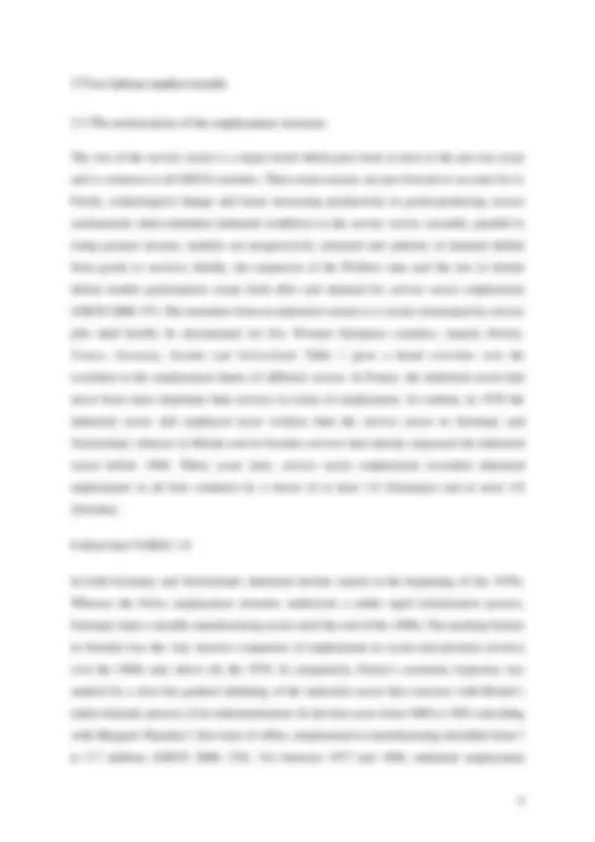

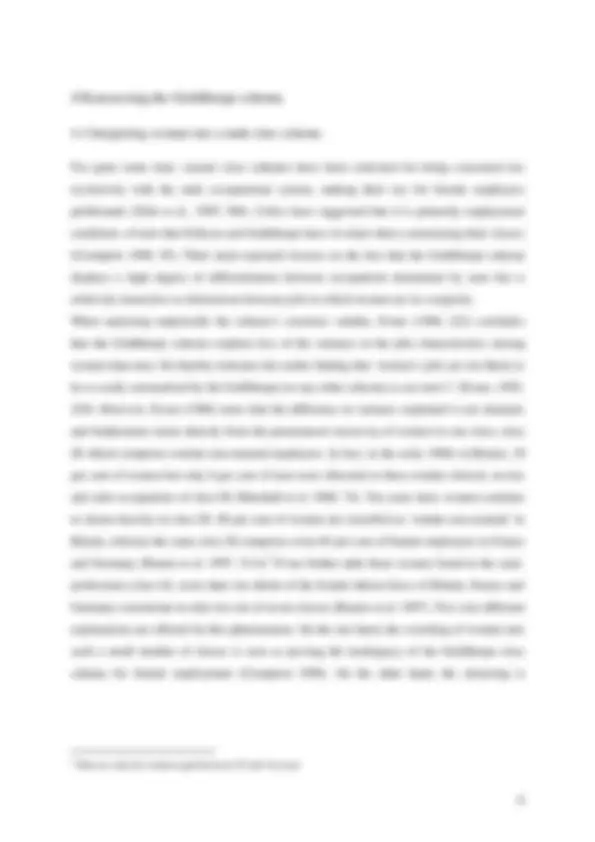
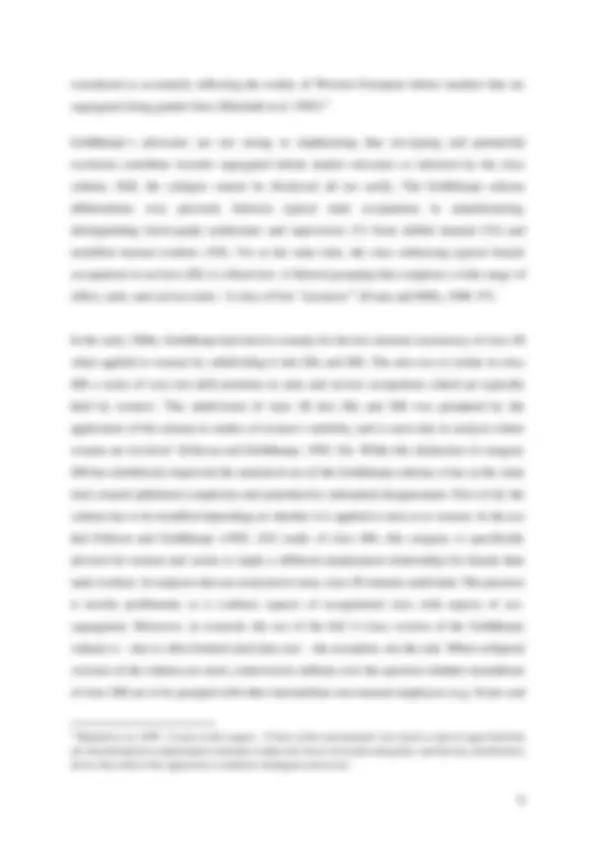
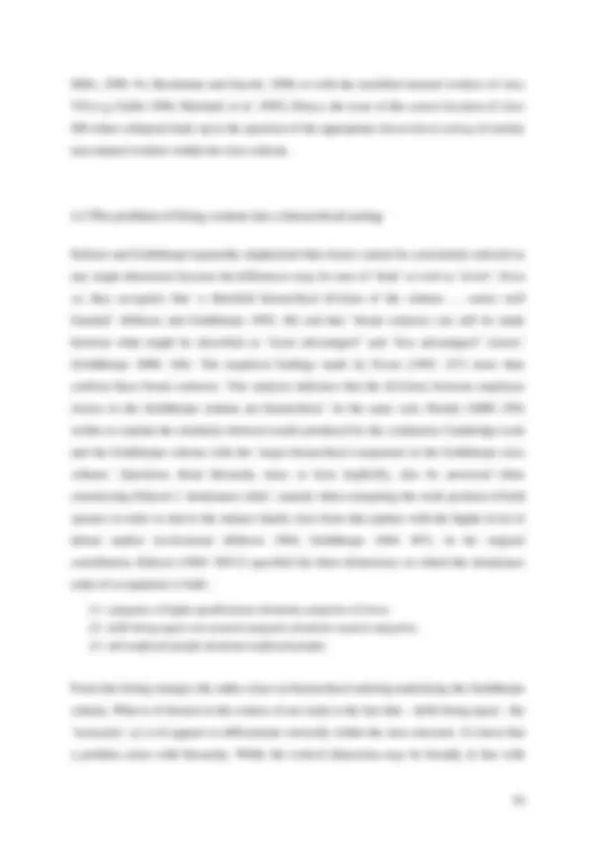
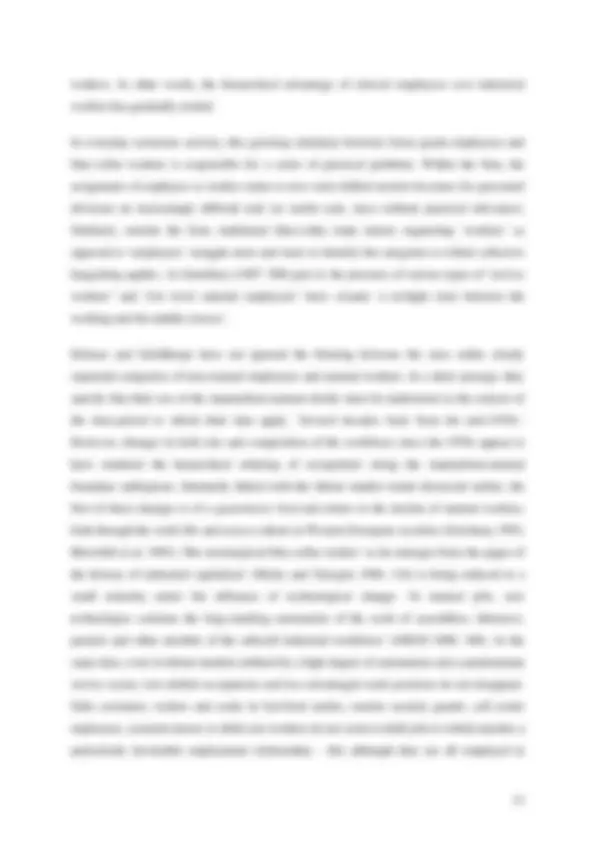

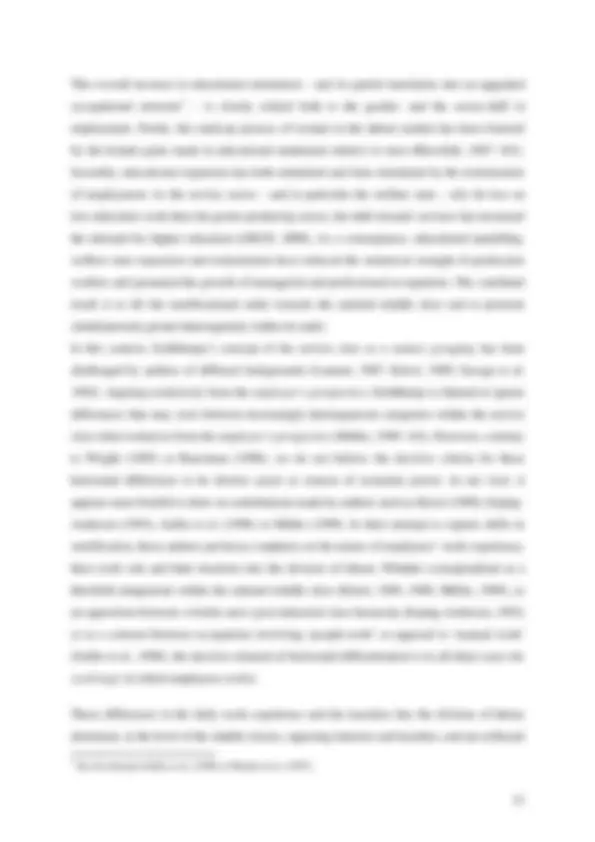
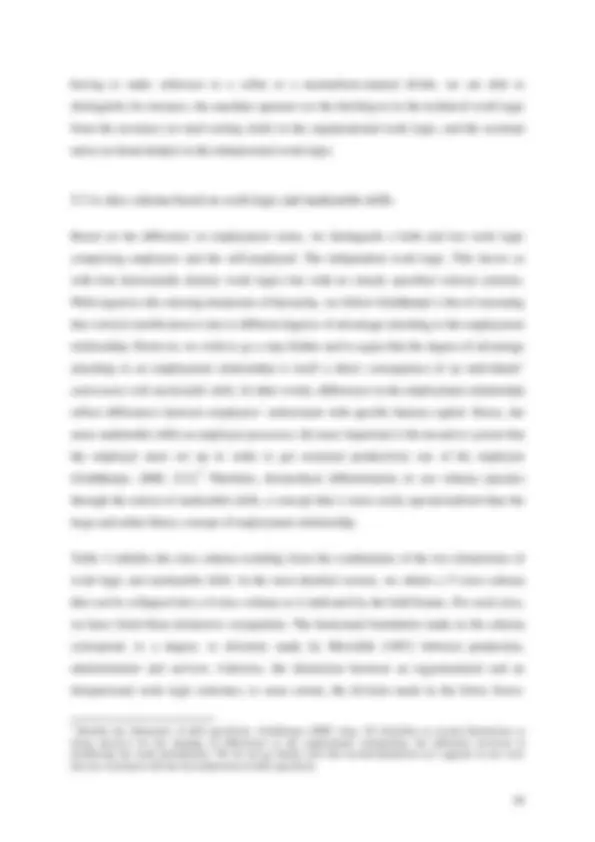
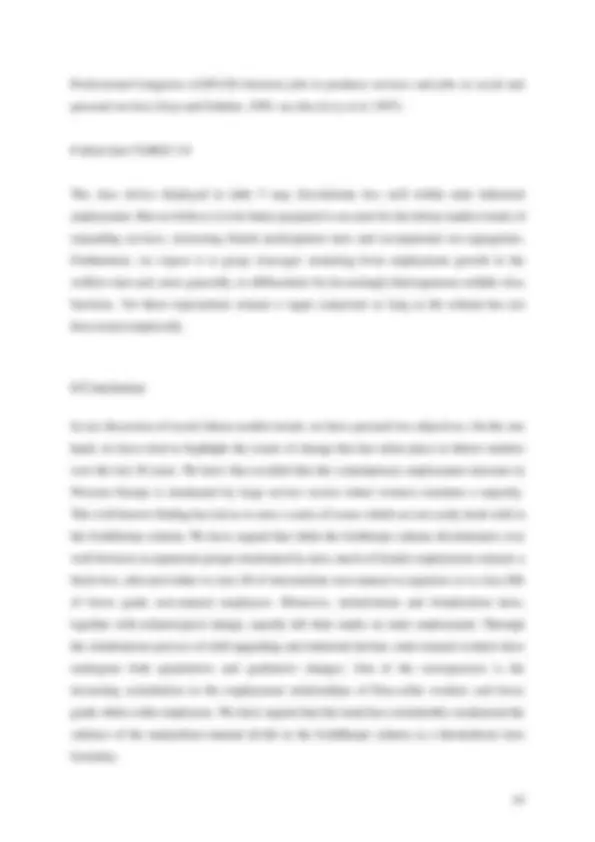





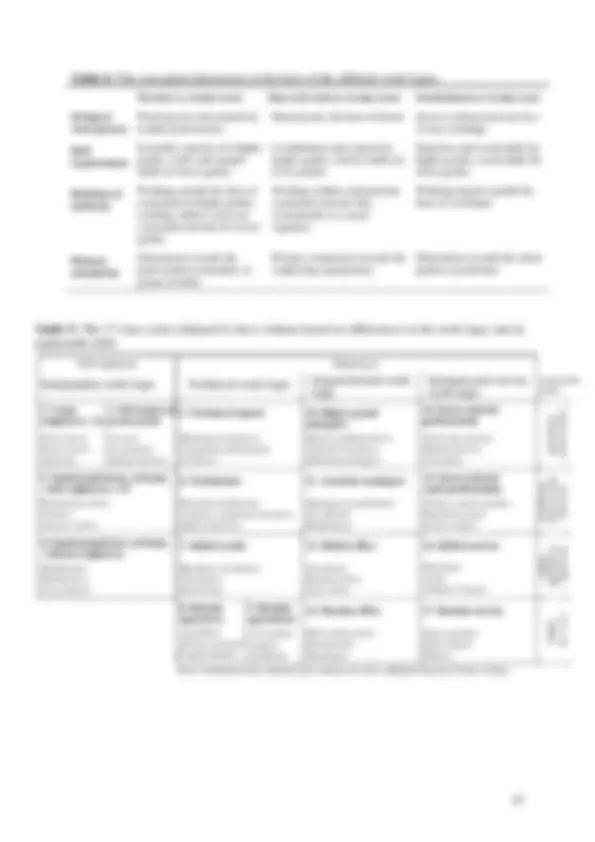



Study with the several resources on Docsity

Earn points by helping other students or get them with a premium plan


Prepare for your exams
Study with the several resources on Docsity

Earn points to download
Earn points by helping other students or get them with a premium plan
Community
Ask the community for help and clear up your study doubts
Discover the best universities in your country according to Docsity users
Free resources
Download our free guides on studying techniques, anxiety management strategies, and thesis advice from Docsity tutors
The limitations of the Goldthorpe class concept in relation to women's employment, focusing on the division of routine non-manual workers into classes IIIa and IIIb. how technological change, income levels, and the expansion of the welfare state have led to an increase in service sector jobs, particularly for women. The document also explores the controversy surrounding the classification of women in the Goldthorpe schema and the implications for their employment relationships.
What you will learn
Typology: Study Guides, Projects, Research
1 / 26

This page cannot be seen from the preview
Don't miss anything!



















DANIEL OESCH^1 (published in: Swiss Journal of Sociology 2003, 29 (2): 241-262)
Class schemas are arguably the most powerful tools for the analysis of different labour market segments. When seen as a proxy for similarity in labour market situation , they provide a conceptual framework that allows to differentiate between various occupational groups and present thus an effective shortcut in empirical research for a series of socio-economic characteristics of individuals (Müller 1997: 759). Probably the most widely used class schema in European sociology is the one associated with the writings of John H. Goldthorpe and his colleagues.^2 There are good reasons explaining why this schema has gained such an influential position in international research on stratification. It relies on a clearly specified conceptual rationale, distinguishing classes on the basis of different employment relationships. Moreover, it has – thanks to its pragmatic scope – proven very useful in empirical inquiry. However, the conceptual bases of the schema have primarily been developed to reflect the employment structure up to the mid-1970s, typical of high industrialism, ‘and not to predict the future’ (Erikson and Goldthorpe 1992: 237). In fact, the by far most influential research using the Goldthorpe class schema is based on data that reflects the employment structure of the mid-1970s and backwards (Erikson and Goldthorpe 1992). Furthermore, the most sophisticated assessment of the schema’s validity rests on data collected in 1984 (Evans 1992, 1996; Evans and Mills 1998), although analyses have been redone with data from 1996 (Evans and Mills, 2000). In this context, we wish to argue that since the early 1980s – and, a fortiori, since the 1970s – a series of socio-economic trends have become more pronounced and substantially altered the employment structure of the economically advanced countries. The question thus arising is
(^1) This contribution is part of an ongoing research project on the impact of labour market changes on stratification and institutions, directed by Hanspeter Kriesi and benefiting from funding by the Swiss National Science Foundation (grant nr 1214-065237). I am grateful for their useful advice to Hanspeter Kriesi, Joanna Barczyk and the anonymous reviewers. 2 Notably: Erikson, Goldthorpe and Portocarero (1979); Erikson and Goldthorpe (1992); it is also known as CASMIM schema (as it was developed for the Comparative Analysis of Social Mobility in Industrial Nations).
whether the Goldthorpe schema still captures the essence of European labour markets that have undergone major transformations over the last twenty to thirty years. In our view, in particular two trends are likely to challenge the schema. On the one hand, the expansion of the service sector at the expense of manufacturing (the sector-shift in the economy); on the other hand, the increased participation of women in paid employment (the gender-shift in employment). These shifts are by no means new and could be completed by additional vectors of change within the labour market such as the adoption of new computerized and information technologies, the introduction of new forms of human resources management or the intensification of international trade (see Gallie, et al. 1998).
Our discussion will be structured as follows. In a first part, we will argue that what looked like blurry tendencies two decades ago has solidified into increasingly tertiarized and feminized labour markets. In a second part, we shall discuss at greater length the implications these changes have on stratification research in general and the Goldthorpe schema in particular. Therein, our main focus will lie on the analytical treatment of female-dominated occupations, on the hierarchical dimension within the schema, and on the ambiguous division line between blue-collar workers and lower grade white-collar employees. Finally, in a last part, we propose some conceptual elements that appear capable of remedying the outlined shortcomings of the Goldthorpe schema. The result will be a modified class schema. Before entering into the discussion, we must quickly recall the construction logic of the Goldthorpe schema.
In devising their class schema, Goldthorpe and his colleagues have a quite modest scope. Unlike other class sociologists (e.g. Wright, 1985), they reject any automatic link between class structure and class action, limiting the theoretical ambition of their class concept to the claim about the existence of social groupings that share particular sets of employment relations over time. Notwithstanding a clearly pragmatic stance – Erikson and Goldthorpe call the schema an ‘ instrument de travail’ –, their class schema is based on a theoretical rationale. Its aim is ‘to differentiate positions within labour markets and production units or, more
The rise of the service sector is a major trend which goes back at least to the pre-war years and is common to all OECD countries. Three main reasons are put forward to account for it: Firstly, technological change and faster increasing productivity in goods-producing sectors continuously shed redundant industrial workforce to the service sector; secondly, parallel to rising general income, markets are progressively saturated and patterns of demand shifted from goods to services; thirdly, the expansion of the Welfare state and the rise in female labour market participation create both offer and demand for service sector employment (OECD 2000: 97). The transition from an industrial society to a society dominated by service jobs shall briefly be documented for five Western European countries, namely Britain, France, Germany, Sweden and Switzerland. Table 1 gives a broad overview over the evolution in the employment shares of different sectors. In France, the industrial sector had never been more important than services in terms of employment. In contrast, in 1970 the industrial sector still employed more workers than the service sector in Germany and Switzerland, whereas in Britain and in Sweden services had already surpassed the industrial sector before 1960. Thirty years later, service sector employment exceeded industrial employment in all four countries by a factor of at least 1.8 (Germany) and at most 3. (Sweden).
In both Germany and Switzerland, industrial decline started at the beginning of the 1970s. Whereas the Swiss employment structure underwent a rather rapid tertiarization process, Germany kept a sizeable manufacturing sector until the end of the 1990s. The marking feature in Sweden was the very massive expansion of employment in social and personal services over the 1960s and, above all, the 1970. In comparison, France’s economic trajectory was marked by a slow but gradual shrinking of the industrial sector that contrasts with Britain’s rather dramatic process of de-industrialisation: In the four years from 1980 to 1983 coinciding with Margaret Thatcher’s first term of office, employment in manufacturing dwindled from 7 to 5.7 millions (OECD 2000: 278). Yet between 1977 and 1986, industrial employment
decline was pronounced throughout Western Europe, particularly affecting the metal, clothing and textile industries and the coal, iron and steel sectors (OECD 1989: 166). Data on the occupational mix of employment show that the increase in the service sector implies a real reduction in the number of jobs involving the direct production of goods relative to the number of jobs involving service-type activities (Tschetter, 1994; OECD 2000: 82). Thus, the practice of goods-producing firms to outsource services accounts for only a very small part of growth in the service sector. In fact, the shift towards services appears to be accompanied by a real occupational change towards less blue-collar and more white-collar jobs, and this within the service as well as the goods-producing sector (Singelmann and Tienda, 1985: 62; OECD 2000: 82).
These features of service expansion bring about a series of implications for stratification. Most importantly for class theory, the rise of service jobs both within the tertiary and the secondary sector calls into question the distinction between manual and non-manual occupations. Already in the middle of the 1980s, the salience of the manual-/non-manual divide had been questioned in the light of the decrease of traditional industrial occupations and the expansion of service jobs (Marshall, et al. 1985: 269). This ongoing decline of the three ‘m’s, the ‘male manual manufacturing worker’ is intimately linked to an evolution which further adds to the theoretical opacity of a hierarchical manual/non-manual divide: The massive inflow of women into Western European labour markets.
In the course of the last three to four decades, women’s employment has grown very significantly in all Western European societies. As is shown in table 2, between 1970 and 2000, female participation rates increased in the five selected countries by at least 14 (Germany) and at most 18 percentage points (Switzerland). Whereas Britain experienced a slow expansion of women in the workforce, Swedish labour market feminization took already place during the decade of the 1970s, coinciding with welfare state expansion and the proliferation of social services. Swiss female employment stagnated until the beginning of the 1980s but grew all the more rapidly during the 1990s, increasing its share from little more
How this joint action of tertiarisation and feminization has transformed the workforces of the countries under study is shown in table 3. In 1970, the dominant category in the labour market were men working in the industries: In all five countries, their share amounted to about a third of total employment. Thirty years later, it has shrunk to 26 per cent in Germany and to a mere 20 per cent in Britain, France, Sweden and Switzerland. The decrease of male industrial jobs stands in a sharp contrast to the growth of female service employment: Accounting for only 20 per cent in the early 1970s (with the notable exception of Sweden), almost two out of five jobs were held by women employed in the service sector three decades later.
Table 3 reflects the clear-cut image of industrially segregated labour markets. Crouch (1999:
(^4) See on the debate: Erikson 1984; Goldthorpe 1983; Heath and Britten, 1984; Marshall et al. 1995; Sørensen
For quite some time, current class schemes have been criticized for being concerned too exclusively with the male occupational system, making their use for female employees problematic (Dale et al., 1985: 388). Critics have suggested that it is primarily employment conditions of men that Erikson and Goldthorpe have in mind when constructing their classes (Crompton 1998: 95). Their main reproach focuses on the fact that the Goldthorpe schema displays a high degree of differentiation between occupations dominated by men but is relatively insensitive to distinctions between jobs in which women are in a majority. When analysing empirically the schema’s construct validity, Evans (1996: 222) concludes that the Goldthorpe schema explains less of the variance in the jobs characteristics among women than men. He thereby reiterates his earlier finding that ‘women’s jobs are not likely to be as easily summarized by the Goldthorpe (or any other schema) as are men’s’ (Evans, 1992: 229). However, Evans (1996) notes that the difference in variance explained is not dramatic and furthermore stems directly from the pronounced clustering of women in one class, class III which comprises routine non-manual employees. In fact, in the early 1980s in Britain, 39 per cent of women but only 6 per cent of men were allocated to these routine clerical, service and sales occupations of class III (Marshall et al. 1988: 74). Ten years later, women continue to cluster heavily in class III: 40 per cent of women are classified as ‘routine non-manual’ in Britain, whereas the same class III comprises even 49 per cent of female employees in France and Germany (Brauns et al. 1997: 33-4).^5 If one further adds those women found in the semi- professions (class II), more than two thirds of the female labour force of Britain, France and Germany concentrate in only two out of seven classes (Brauns et al. 1997). Two very different explanations are offered for this phenomenon. On the one hand, the crowding of women into such a small number of classes is seen as proving the inadequacy of the Goldthorpe class schema for female employment (Crompton 1998). On the other hand, the clustering is
(^5) Data are only for women aged between 25 and 44 years.
Mills, 1998: 91; Buchmann and Sacchi, 1998) or with the unskilled manual workers of class VII (e.g. Gallie 1996; Marshall, et al. 1995). Hence, the issue of the correct location of class IIIb when collapsed leads up to the question of the appropriate hierarchical setting of routine non-manual workers within the class schema.
Erikson and Goldthorpe repeatedly emphasized that classes cannot be consistently ordered on any single dimension because the differences may be ones of ‘kind’ as well as ‘levels’. Even so, they recognize that ‘a threefold hierarchical division of the schema … seems well founded’ (Erikson and Goldthorpe 1992: 46) and that ‘broad contrasts can still be made between what might be described as “more advantaged” and “less advantaged” classes’ (Goldthorpe 2000: 166). The empirical findings made by Evans (1992: 227) more than confirm these broad contrasts: ‘Our analysis indicates that the divisions between employee classes in the Goldthorpe schema are hierarchical.’ In the same vein, Prandy (2000: 250) wishes to explain the similarity between results produced by the continuous Cambridge scale and the Goldthorpe schema with the ‘major hierarchical component in the Goldthorpe class schema’. Questions about hierarchy must, at least implicitly, also be answered when constructing Erikson’s ‘dominance order’; namely when comparing the work position of both spouses in order to derive the unitary family class from that partner with the higher level of labour market involvement (Erikson 1984; Goldthorpe 1984: 497). In his original contribution, Erikson (1984: 504-5) specified the three dimensions on which the dominance order of occupations is built :
(1) categories of higher qualifications dominate categories of lower; (2) skills being equal, non-manual categories dominate manual categories; (3) self-employed people dominate employed people;
From this listing emerges the rather clear-cut hierarchical ordering underlying the Goldthorpe schema. What is of interest in the context of our study is the fact that – skills being equal – the ‘ manuality’ of work appears to differentiate vertically within the class structure. It is here that a problem arises with hierarchy: While the vertical dimension may be broadly in line with
male employment of the manufacturing sector, it does not seem adequate for service employment in general and women in particular. This becomes clear when the internal composition of class IIIb is looked at more closely. It reveals, as Erikson and Goldthorpe (1992: 241) readily admit, ‘occupations which in terms of their characteristic employment relations would seem to entail straight-forward wage-labour’. Focusing on women, Heath and Britten (1984: 478) provide a similar description of Goldthorpe’s class III: ‘There will be sizeable components of personal service workers whose work and market situation we had never supposed to be other than “proletarian”’. In terms of coverage with sick pay or pension schemes, sales and personal service workers are in no respect better off than semi-skilled or unskilled manual workers. Moreover, in terms of level of pay, incumbents of class III seem to fare substantially worse than manual workers of classes VI and VII (Heath and Britten 1984; Esping-Andersen et al. 1993; Evans and Mills 1998: 99). It appears thus highly questionable whether routine non-manual occupations are defined by a more advantaged employment relationship than manual occupations. According to Crouch (1999: 165), there are no grounds for regarding the lower levels of the non-manual hierarchy as somewhat superior to manual work.
But why then are routine non-manual employees in the Goldthorpe schema allocated to an intermediate setting which prevails over the class position of manual workers? The response lies in the persisting attraction of the manual/non-manual divide as a class boundary. However, the divide’s salience as regards women’s employment has been widely criticized for over two decades. Interestingly, Goldthorpe (1983: 480) himself relativized the importance of the manual/non-manual divide for women. In a short passage, he explained the raison d’être of the manual/non-manual divide:
‘From the standpoint of class analysis, the distinction between manual and non-manual work is not in itself of any great significance. So far as men are concerned, this distinction is of value as an indicator of class position because of the fact that it is quite closely correlated with differences in market and work situations … .’ (Goldthorpe, 1983: 480; emphasis in the text)
Thus, the manual/non-manual divide may well be inadequate for female employment. Yet according to Goldthorpe, it appears to keep its salience in respect with men. This argument shall be discussed more in detail next.
workers. In other words, the hierarchical advantage of clerical employees over industrial workers has gradually eroded.
In everyday economic activity, this growing similarity between lower grade employees and blue-collar workers is responsible for a series of practical problems. Within the firm, the assignment of employee or worker status to new semi-skilled recruits becomes for personnel divisions an increasingly difficult task (or sterile task, since without practical relevance). Similarly, outside the firm, traditional blue-collar trade unions organizing ‘workers’ as opposed to ‘employees’ struggle more and more to identify the categories to which collective bargaining applies. As Sainsbury (1987: 508) puts it, the presence of various types of ‘service workers’ and ‘low level salaried employees’ have created ‘a twilight zone between the working and the middle classes’.
Erikson and Goldthorpe have not ignored the blurring between the once rather clearly separated categories of non-manual employees and manual workers. In a short passage, they specify that their use of the manual/non-manual divide must be understood in the context of the time-period to which their data apply: ‘Several decades back from the mid-1970s’. However, changes in both size and composition of the workforce since the 1970s appear to have rendered the hierarchical ordering of occupations along the manual/non-manual boundary ambiguous. Intimately linked with the labour market trends discussed earlier, the first of these changes is of a quantitative kind and relates to the decline of manual workers, both through the work-life and across cohorts in Western European societies (Gershuny 1993; Blossfeld et al. 1993). The stereotypical blue-collar worker ‘as he emerges from the pages of the history of industrial capitalism’ (Myles and Turegun 1996: 116) is being reduced to a small minority under the influence of technological change: ‘In manual jobs, new technologies continue the long-standing automation of the work of assemblers, labourers, packers and other member of the subcraft industrial workforce’ (OECD 1988: 188). At the same time, even in labour markets defined by a high degree of automation and a predominant service sector, low-skilled occupations and less advantaged work positions do not disappear. Sales assistants, waiters and cooks in fast-food outlets, routine security guards, call centre employees, assistant nurses or child care workers do not seem to hold jobs to which attaches a particularly favourable employment relationship – this although they are all employed in
occupations that, commonly, are neither considered to be manual nor blue-collar and could, in the more precise use of French or German, hardly be qualified as ouvriers or Arbeiter. In short, these employees are in the awkward hierarchical setting of Goldthorpe’s intermediate class III. The relative opacity of the manual/non-manual divide is, however, not solely reducible to this category. Under the influence of automation, manual manufacturing work has equally undergone a qualitative change of skill upgrading. In an empirical analysis of the blue-collar / white-collar divide, Gallie (1996) re-examines whether the spread of new technologies has undercut the differences in the employment relationship of lower non-manual and manual workers in Britain. The underlying hypothesis suggests that automation improves the working conditions of the latter as compared to the former. Gallie (1996: 471) finds evidence ‘that the spread of new technologies has been accompanied by significant areas of convergence in the work and labour market situations of lower non-manual and manual employees.’ He therein confirms the findings made for Germany by Kern and Schumann (see Kern, 1998).
So far, we have argued that simultaneous growth in women’s paid work and in service sector employment have rendered the class structure both more heterogeneous and more opaque, thereby undermining some of the divisions made in the Goldthorpe schema. However, we have not presented any elements remedying what we consider shortcomings. An attempt in this direction shall be outlined in the following section.
As starting point for our reflection about more salient class divisions serves the presentation of a third labour market trend that has deliberately been left out until now: Massive educational expansion and occupational upgrading. A look on statistics exhibits the extent of this process. Between 1960 and the mid-1990s university population has expanded by a ratio of 4.3 in Britain and Switzerland, by 5.6 in Germany, and even by 6.6 in France and 6.8 in Sweden (Mitchell, 1998). Even bigger gains were made below the academically-oriented university level in tertiary degrees with a vocational orientation (Brauns et al. 1997).
in differences in political behaviour. Empirical research shows that in Germany, the Netherlands and Switzerland, managers and administrators clearly lean towards the right, whereas professionals in the social and cultural services strongly favour the left. Technical experts take an intermediate stance (Kriesi, 1998; Müller, 1999; Dutch , 2003; see also Brooks and Manza, 1997 for the U.S). Unlike assets, we argue that the criterion of differences in the work logics is not limited to individuals of the salaried middle class and thus permits to extend the horizontal division to the ‘twilight zone’ of routine employees and blue-collar workers.
In contrast to what much of the class debate suggests, the work settings of the craft worker or the assembly-line worker is representative for only a small part of the male labour force. Given the high level of segregation in the employment structure, much of the growth of female employment in recent decades has been in very different sectors of the labour market – namely in the social and personal services. As Gallie et al. (1998: 30) note in a large empirical study on the employment relationship, this has wide-ranging consequences for the work logic: ‘The very nature of much work in the services is radically different, involving primarily relationships with people and requiring social rather than manual skills’. Hence, unlike clerical or manual jobs, a large part of service work implies the direct handling of individuals’ needs through face-to-face interaction. Not surprisingly, women in general and (largely female) welfare state personnel in particular are heavily overrepresented in this group of employees. Moreover, ‘people-work’ is not limited to qualified employees. Gallie et al. (1998: 52) find that a substantial proportion of semi- and unskilled workers are equally engaged in work involving caring for other people or directly responding to clients’ needs. By integrating the notion of interpersonal service work into the cleavages highlighted for the salaried middle class, we are able to distinguish three basically different work logics: a technical work logic, an organizational work logic and an interpersonal work logic. Depending on whether an occupation involves the administration of organizational power, the handling of technical expertise and manual tasks or the face-to-face dealing with people’s personal demands, the work logic and accordingly the primary orientation differ in
fundamental ways. In table 4, we show the four dimensions along which the different work logics are separated: (a) the setting of the work process; (b) skill requirements; (c) relations of authority; (d) primary orientation.
This triple distinction of work logics is of a somewhat schematic nature. Yet besides substituting misleading hierarchical divisions such as the ‘blue-collar/white-collar’ or ‘manual/non-manual divide’ by a horizontal distinction, it appears to overlap rather closely with empirically observable cleavages in the employment structure. Hence at the level of the middle classes , it reflects central differences between categories such as technicians (e.g. computer assistants and safety inspectors), associate managers (e.g. junior financial managers and customs officials) and socio-cultural semi-professionals (e.g. primary school teachers and physiotherapists) who otherwise, on the basis of similar advantages that attach to their employment relationships, are to be placed into the same class.^8 Let’s briefly outline the nature of these differences. Being part of the bureaucratic division of work tasks, the associate manager depends on his ability to coordinate and control others, while evolving himself in a system of authority relations that frequently corresponds to a career sequence. Through his (present or future) participation in organizational power, he is expected to show a high level of loyalty towards the employing organization. In contrast, the socio-cultural semi- professional is primarily dependent on social skills (and expertise) and evolves in a autonomous work setting that practically lies outside the lines of command. As he depends on the cooperation of his ‘clients’ (the students, patients or petitioners) in providing his services, he is likely to advocate their interests against organizational interference. Finally, the technician is in an intermediate position. His daily work experience makes him more likely to direct his primary orientation towards his professional community and its body of knowledge than the organization. At the same time, the technical nature of his work tasks provides more potential for the division of labour than is the case in the interpersonal service logic. At the level of the working classes , the same criteria of work logic captures the horizontal differences between categories that in terms of hierarchy are not easily separated. Without
(^8) In the Goldthorpe class schema, these occupations are all allocated into “service class II” of lower grade professionals, administrators, and officials.
Professional Categories (CSP-CH) between jobs in producer services and jobs in social and personal services (Joye and Schuler, 1995; see also Levy et al. 1997).
The class device displayed in table 5 may discriminate less well within male industrial employment. But we believe it to be better prepared to account for the labour market trends of expanding services, increasing female participation rates and occupational sex-segregation. Furthermore, we expect it to grasp cleavages stemming from employment growth in the welfare state and, more generally, to differentiate for increasingly heterogeneous middle class fractions. Yet these expectations remain a vague conjecture as long as the schema has not been tested empirically.
In our discussion of recent labour market trends, we have pursued two objectives. On the one hand, we have tried to highlight the extent of change that has taken place in labour markets over the last 30 years. We have thus recalled that the contemporary employment structure in Western Europe is dominated by large service sectors where women constitute a majority. This well-known finding has led us to raise a series of issues which are not easily dealt with in the Goldthorpe schema. We have argued that while the Golthorpe schema discriminates very well between occupational groups dominated by men, much of female employment remains a black box, allocated either to class III of intermediate non-manual occupations or to class IIIb of lower grade non-manual employees. Moreover, tertiarization and feminization have, together with technological change, equally left their marks on male employment. Through the simultaneous process of skill-upgrading and industrial decline, male manual workers have undergone both quantitative and qualitative changes. One of the consequences is the increasing assimilation in the employment relationships of blue-collar workers and lower grade white-collar employees. We have argued that this trend has considerably weakenend the salience of the manual/non-manual divide in the Goldthorpe schema as a hierarchical class boundary.
As a consequence of our critiques, we have proposed an alternative class device that partly shift its focus from vertical divides to horizontal cleavages, thus separating employees and workers that share an equally advantaged or disadvantaged labour market position but evolve nonetheless in a fundamentally different work setting. In our view, the criterion that allows to operate such a division is the difference in the work logic. However, whether this class device based on both differences in employment relationships and in work logic contributes to the understanding of labour market stratification remains an open question as long as it has not been resolved with the use of data. This task will be tackled next.